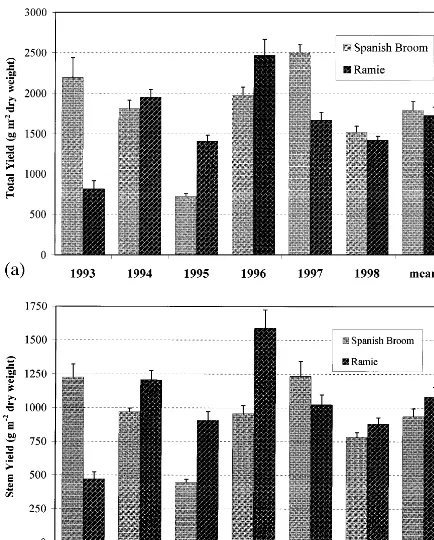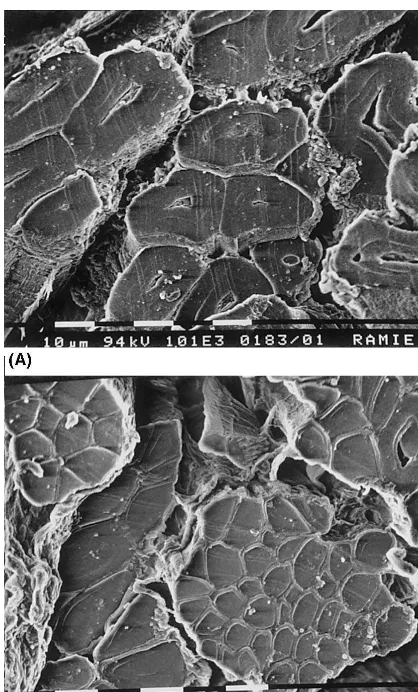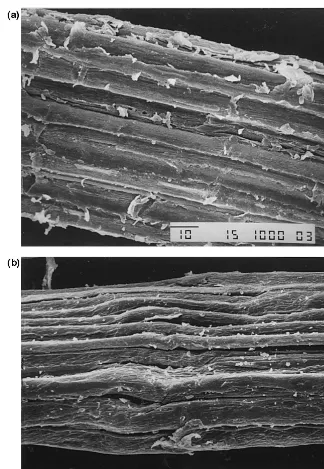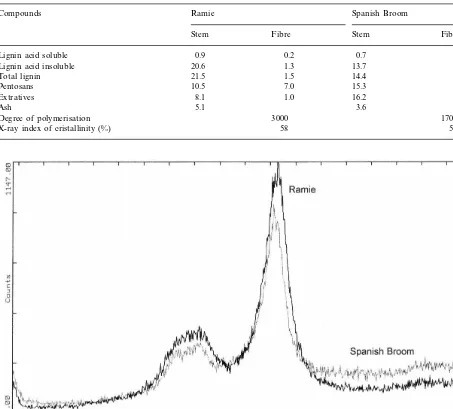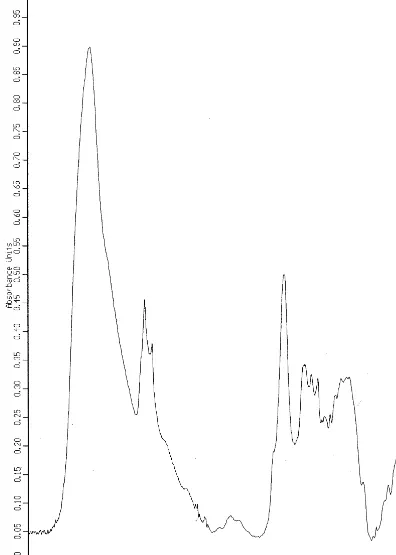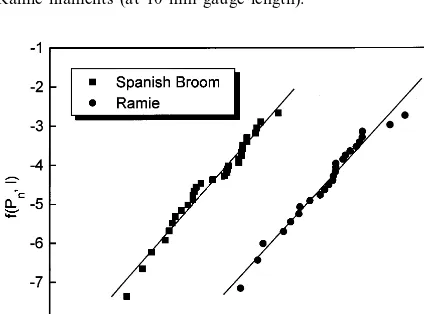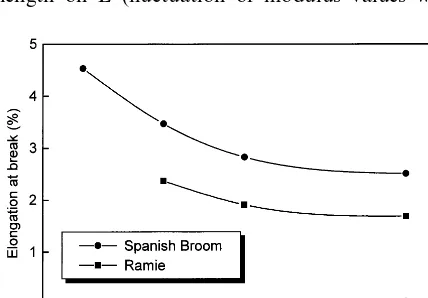Ramie (
Boehmeria ni
6
ea
(L.) Gaud.) and Spanish Broom
(
Spartium junceum
L.) fibres for composite materials:
agronomical aspects, morphology and mechanical properties
L.G. Angelini
a,*, A. Lazzeri
a, G. Levita
b, D. Fontanelli
b, C. Bozzi
c aDipartimento di Agronomia e Gestione dell’Agroecosistema,Uni6ersity of Pisa,Via S.Michele degli Scalzi2,56124Pisa,Italy
bDipartimento di Ingegneria Chimica,Uni
6ersity of Pisa,Via Diotisal6i2,56100Pisa,Italy
cStazione Sperimentale Cellulosa,Carta,Fibre tessili Vegetali ed Artificiali,P.zza L.da Vinci,20133Milano,Italy Accepted 8 October 1999
Abstract
The agronomic characteristics of Ramie and Spanish Broom were investigated for seven years in the pedoclimatic conditions of Central Italy. The chemical, physical and mechanical properties of these fibres were also examined in order to evaluate the feasibility to use them in composite materials. Results demonstrate that Ramie grown in the temperate environment can be harvested three times a year. The yield of green Ramie plants per annum was almost 10 000 g m−2. The fresh Ramie plant is composed, by weight, of 30% green leaves and 70% green stems. The yield
dry fibre is almost 3% of the green stems, giving a total yield of 200 g m−2. Spanish Broom can reach a fresh biomass
yield of 4000 g m−2 per annum, represented by 53% of long slender terete green branches which constitutes the
economic products. The dry yield per annum was about 1800 g m−2with a dry branchlets yield of 900 g m−2. Ramie
and Spanish Broom cortical fibres are multiple elementary fibres (ultimates) arranged in bundles. In Ramie, the elementary fibres are bound by gums and pectins, while in Spanish Broom they are bound together by lignin. Both species showed a thick secondary cell wall indicating a high cellulose content. Ramie ultimate fibres are flattened and irregular in shape, while those of Spanish Broom are more regular in shape. The diameter of the ultimates varies from 10 to 25mm in Ramie, while the Spanish Broom ultimates ranges from 5 to 10mm; the diameter of the whole bundle is about 50mm for both species. Ramie fibre showed a content of lignin, pentosans and extractives lower than Spanish Broom. Both fibres had a high content of cellulose which, on the base of X-ray analysis, was evaluated to be in excess of 70%. Ramie and Spanish Broom fibres had tensile strength of 950 MPa and 700 MPa, respectively. The elastic moduli were:65 and :20 GPa, respectively, which well compare with the modulus of E-glass fibres (70 – 90 GPa). The strength of the fibre-matrix interface was measured using the single filament fragmentation technique and an epoxy resin as the polymer matrix. Values for carbon and glass fibres in the same resin were also measured for comparison. The interface strength for the vegetable fibres was higher than that of carbon and glass, likely due to a mechanical lock mechanism. These values confirm both fibres as potential replacement for man made fibres in composite materials. © 2000 Elsevier Science B.V. All rights reserved.
www.elsevier.com/locate/indcrop
* Corresponding author. Tel.: +39-50-599111; fax: +39-50-540633.
Keywords:Boehmeria ni6ea;Spartium junceum; Spanish Broom; Ramie; Fibre; Mechanical properties; Interface strength; Composite
materials
1. Introduction
Application of vegetable products in various branches of industry will benefit from their intrin-sic biocompatibility and biodegradability. Indus-tries all over the European Community are looking for raw material for replacing artificial fibres in composite materials (CMs) to alleviate problems related with CMs disposal at the end of the technical life. Vegetables fibres could be a viable alternative to man-made fibres (especially asbestos and glass fibres) at least in applications in which the overall performance, evaluated in term of life cycle analysis, has to take into ac-count the final disposal. A number of suitable plant fibres can be successfully grown in Italy, including Ramie (Boehmeria ni6ea (L.) Gaud.), a
member of the Urticaceae, and Spanish Broom (Spartium junceumL.) for which promising agro-nomic results have been obtained (Oggiano et al., 1997).
Ramie is a perennial plant native to China, Japan, and the Malay Peninsula, where it has been used as a textile fibre for centuries due to its excellent fibre (Kirby, 1963; Wood and Angus, 1974; Batra and Bell, 1975). The fibres, obtained from the outer part of the stem, are the longest and one of the strongest fine textile fibres (Dempsey, 1975; Jarman et al., 1978). Other ad-vantages of this fibre is the resistance to bacteria, mildew, and insect attack. Its strength slightly increases when wet (Fontanelli, 1998).
Spartium junceum (belonging to the Legumi-nosae family) is a perennial shrub, wide-spread throughout the Mediterranean area (Munz and Keck, 1973; Pignatti, 1982) where it naturally occurs in hilly soils, contributing to lower erosion and risks of nutrient leaching. This plant is some-what adapted to alkaline and salty soils. The name Spartium is from the Greek word denoting ‘cardage’, in allusion to the use of the plant. By macerating the twigs a good fibre was obtained, which was made into thread and cords and a
coarse sort of cloth. It was cultivated on a large scale in southern Italy around the thirties; but later it fell out of favour. Recently there has been a revival of interest in Spanish Broom as a possi-ble source of raw materials to be used in CMs for automobile applications.
The agronomic characteristics of Ramie and Spanish Broom were investigated for seven years in the pedoclimatic conditions of Central Italy. In order to evaluate the feasibility to use Ramie and Spanish Broom fibres in composite materials, the morphology and chemical composition together with physical and mechanical properties of these fibres were also examined.
2. Materials and methods
2.1. Agronomic aspects
A 7-year field trial was set up at the Depart-ment of Agronomy of the University of Pisa (about 43°N; 10°E; 3 m elevation) on a deep silt loam soil (sand 15.5%; silt 65.5%; clay 18.0%; organic matter 1.15%; pH 8.1; total nitrogen 1.3%; assimilable P2O535 mg kg
−1; exchangeable
K2O 165 mg kg
−1). The soil was characterised by
a water table rather superficial with a deph of 120 cm during the driest season. The soil displayed the following hydrological characteristics: field capac-ity, 27.3% dw, wilting point 9.4% dw.
Meteorological conditions during the seven years of study are shown in Table 1.
The experiment was laid out in a randomised block design with four replicates. Plot size was 48 m2
. In Ramie they consisted of 16 rows, each 6 m long, with an interrow and interplant
spac-ing of 0.5 m. For Spanish Broom a plant den-sity of 2 plants m−2 (0.1×0.5 m) was
adopted and each plot consisted of 8 rows, each 6 m long.
Table 1
Climatic conditions during trials in 1992–1998 and 1918–1982 mean values
S O N D
F M A M J
Years/Months J J A
Rainfall(mm)
115.7 191.4 50.6 87.3 15.0 17.5
1992 45.0 82.5 101.8 79.4 18.8 60.6
78.7 36.0
192.3 91.4 122.9 84.1 21.4 2.0
1994 58.2 123.3 22.3 62.4 1.5 0.8
25.4 88.6 58.4
1995 101.2 56.8 136.4 91.1 40.6 2.1 8.2 108.1 71.6
114.5
2.8 77.5 16.1 83.1 49.7 44.5 12.2 98.1 91.7 224.6 122.6 1996
45.9 37.5 82.4 95.6 21.3
1997 118.0 21.1 55.0 25.0 58.4 7.2 0.0
98.2 95.3 42.2 56.6 56.9 49.0 49.0
1998 73.6 24.2 44.8 1.7 8.8
118.0 99.0 79.0
80.0
1918–1982 89.0 77.5 67.2 46.4 25.0 42.0 83.7 134.2
Temperature min.(°C)
1998 3.6 10.5 14.4 16.3 17.8
6.9 3.7
15.0 17.2 14.8
1918–1982 2.8 2.3 5.3 8.1 11.6 17.0 11.0
Temperature max(°C)
11.9 13.4 15.6 17.5 24.0 24.3 27.5 29.7 20.5 17.3 12.7
1992 25.8
12.1 13.3 13.9 17.4 22.8 27.9 28.2 31.3 18.0 14.5 14.2
1993 25.9
1994 13.7 12.7 17.6 17.7 22.5
11.1 13.3 13.8 18.0 21.1 23.8 29.8 28.6 23.1 15.6 12.8
1995 23.9
16.5 12.4 12.6
1996 11.3 14.3 17.9 21.6 27.0 28.3 28.8 23.7 21.1
21.6
13.7 10.8 17.9 17.4 23.2 25.7 28.0 30.8 27.7 16.1 13.1 1997
24.9 21.1 14.1 10.5 15.0
1998 12.9 15.8 15.8 23.3 26.4 28.8 29.4
26.2 21.3 15.8 12.0 1918–1982 11.2 12.7 15.1 18.3 22.4 26.1 29.1 29.2
Table 2
Dates of vegetative regrowth and of harvest for Ramie and Spanish Broom at Pisa in the different years of growtha Spanish Broom
1993 18 April – 08 August 21 October 03 April 11 September
18 October 04 April
18 October 24 August
1994 01 March 21 June
19 September – 03 April
1995 26 February 10 July 22 October
1996 01 March 12 June 05 September 02 December 06 April 05 November 25 November 27 March 24 October 18 September
18 February 09 July 1997
15 September – 26 March
1998 01 March 08 June 29 September
In order to evaluate maximum crop yield, plants were maintained in optimum water supply conditions. All plots received the same amount of N, P, and K: 100 Kg ha−1per year. The nitrogen
dose was split into two equal pre-planting and late-spring applications. During the second and the third growing seasons, plots received only 50 Kg ha−1 of N in a single dose at the end of
winter. Plots were kept weed free by hand hoeing. The establishment year was not considered and crops were tested starting from the second grow-ing season. Screengrow-ing of these species for pheno-logical and biometrics characteristics as well as for above-ground biomass and stem production was carried out from 1993 to 1998. Cycle length was measured as the number of days from vegeta-tive regrowth to harvest.
Biometrics and productive determinations were performed on a minimal area of 6 m2in the inner
part of each plot. According to Iyengar and Bhu-jang (1961) Ramie harvests were usually accom-plished when the lower part of the stem was turning brown. Spanish Broom was harvested only once in autumn and plants were cut at 15 cm from the soil. Aerial dry matter was separated in the different plant organs. The useful part was represented by stems without cymes and leaves for Ramie and by new branches for Spanish Broom. After harvest, all plants in the plots were cut 10 – 15 cm above ground for allowing uniform vegetative regrowth.
Both species were harvested by hand. Spanish Broom new branches and Ramie dry stalks, with leaves and cymes removed, were decorticated us-ing a small decorticatus-ing machine in order to remove the outer bark/epidermis and the bast from the woody core of the stems. Several stalks were passed through fluted crushing rollers at the entrance to the machine. Stalks were thereby con-strained as their full length was decorticated in one pass through the machine. During this opera-tion the cortex, comprising the bast and outer bark, was removed from the stem. The cortex was scraped to remove most of the outer bark and the parenchyma in the bast and, for Ramie, some of the gums and pectin. After decortication the fibres were hand brushed for make them suitable for physical and mechanical testing.
2.2. Morphological, chemical and mechanical characterisation
Fibre bundles were confined in small plastic sleeves and then cross-sectioned. Scanning mi-croscopy (SEM) was carried out on gold coated cross-sections.
X-Ray patterns were recorded using Ni-filtered Cu – K radiation from a Siemens 500 D diffrac-tometer equipped with a scintillator counter and a linear amplifier.
Fourier-transform infrared spectroscopy (FTIR) spectra were obtained with a Bruker IFS 66-FTIR spectrometer on samples dispersed in KBr; 32 scans were accumulated for each sample, with a resolution of 4 cm−1.
In accordance with the TAPPI OM 250 method, the lignin content was determined as the sum of insoluble and soluble lignin, the latter being determined spectrophotometrically at 205 nm.
Pentosan content was determined according to the TAPPI T 223 hm 84 and ash content accord-ing to the TAPPI 15 OS 58 method.
The TAPPI 284 OM 82 method was used to assess the extractives content and the UNI 8282 method to determine the degree of cellulose poly-merisation in cupriethylenediamine (CED) after delignifying the material with sodium chlorite.
2.2.1. Fibre strength
The elastic modulus (E) was measured by the slope of the conventional stress-strain curves tak-ing the distance between grips as the gauge length. To measure the strength of fibres different gauge lengths were used, in the range 10 – 50 mm; a minimum of 50 filaments was taken for each gauge length to give data statistical meaning.
2.2.2. Single fibre composite (SFC) tests
A silicon rubber mould was used to make dog-bone shaped single fibre coupons (approximately 60 mm long, 10 mm wide, 1 mm thick). Filaments were selected as to assure their diameters were similar (:50 mm).
The epoxy resin was a bifunctional bisphenol-A type with an epoxy equivalent of :195 (Epikote 828 by Shell). The hardener was p -amine-dicy-cloexyl-methane, used at the content of 25% by weight. Resin and hardener were intimately mixed at room temperature and freed from air bubbles by degassing at 50°C for 10 min in a vacuum oven. The mould containing the filaments was also equilibrated at 50°C prior to resin pouring. The casts were cured at 70°C for 2 h and post-cured at 100°C for 3 h.
The coupons were slowly strained in an Instron tensile machine (1185) at the crosshead speed of 0.02 mm/min. The fragmentation of the fibre was observed by means of a microscope attached to the machine, at magnification 40, both in natural and polarised light. The fragment lengths were measured by the help of a calibrated eyepiece. Tests were repeated with identical coupons to get at least 100 fragments for collecting a reasonable number of fragments.
The interfacial strength of HS-Carbon fibres and of E-Glass fibres was measured, for compari-son, using the same epoxy resin as the matrix.
3. Results and discussion
3.1. Agronomic data
Ramie and Spanish Broom crops growth ceased during the winter months. In spite of its tropical origin Ramie plant resists well the winter low temperatures-such as the minimum temperatures
below 0°C experienced in 1993 and 1995 winter-thanks to the protection offered to rootstocks by a layer of dead leaves. Both species did not seem to withstand prolonged waterlogging. Soils with poor drainage and high water retention must be avoided, but at the same time the soil must have a good water retaining capacity. Spanish Broom and Ramie are perennials, and the production cycle is up to 20 years (Trotter, 1941; Bruno, 1951; Jarman et al., 1978), however this estimates is not supported by experimental evidence.
In Ramie vegetative regrowth generally began at the end of February (Table 2) and stems are sent up from underground rootstocks; during the following months the stems elong rapidly with few branches. The species shows a good competition toward weeds due to a rapid interrow closure (30 days after regrowing). Stems ranged from 1.2 to 1.6 m high and about 0.8 to 1.2 cm in diameter, depending on the climatic conditions experienced in the different years. Stems were cut during the growing season and therefore the rootstocks send up new shoots, and consequently several crops can be taken from the plant each year. According to Bally (1957), the first crop after planting is very poor and unsuitable for fibre production. In each year, the time of harvest is very important; if delayed the stems become lignified and it is difficult to remove the fibre. First-crop Ramie was usually harvested before flowering (June) and the second crop during the peak of flowering (Sep-tember). In each case the correct harvesting time was when the stem bases had just turned brown (Iyengar and Bhujang, 1961).
Results demonstrate that Ramie grown in Cen-tral Italy under temperate environment can be harvested three times a year. The third cutting is usually performed during late autumn and there-fore is often at risk for the low temperatures and rainy conditions during this period.
Fig. 1. Total dry yield (a) and stem dry yield (b) of Ramie and Spanish Broom in the different growing seasons and as overall mean (establishment year not included). Values are the mean of four replications and bars correspond to the mean standard error.
cymes. The yield of dry Ramie plants per hectare per annum was 1905 g m−2 (Fig. 1a) with a dry
stem yield of 1202 g m−2 (Fig. 1b). The dry
Ramie plant was composed by weight of 62% dry stems and 38% dry leaves and cymes. The final product was obtained mainly from the first and second harvest, which gave 93% of the yearly production as dry stems (Fig. 2).
The crop reaches its full productivity in the year after planting; in the following years Ramie pro-duction depended on climatic conditions rather than on the age of the crop. Rainfalls during the summer months strongly affected the yield and higher production were observed during the most rainy summer seasons such as 1996 (735 mm from vegetative regrowth, VR, until third cutting, C3) and 1994 (457 mm from VR to C3).
According to Iyengar and Bhujang (1961), Ramie can be harvested in the tropics three or four times a year when grown under favourable conditions; however, with supplementary irriga-tion and fertiliser applicairriga-tion more than six har-vests a year are possible (Dempsey, 1975). According to Dempsey (1975) the number of crops is reduced to two or three annually as the climate becomes more temperate. Although Ramie can be harvested more frequently in the tropics yields per crop are lower, annual yields per hectare in the tropic and in the temperate zones are consequently similar.
The yield dry fibre was almost 3% (Dempsey, 1975; Jarman et al., 1978) of the green stems, giving a total fibre yield of about 200 g m−2 as
1994 – 1998 mean value.
In Spanish Broom vegetative regrowth gener-ally began at the beginning of April (Table 2). Plants reached up to 2 m high, with long, slender, leafless or few-leaved, green, rushlike branchlets. The above ground plants were cut at the end of the growing season (Table 2).
This crop performed well after the establish-ment year (1992), reaching in 1993 a total fresh biomass of about 4700 g m−2 corresponding to
2200 g m−2dry yield (Fig. 1a). The dry yield was
composed of 56% new branches, representing the economic yield. When established, Spanish Broom can reach a fresh biomass yield about of 4000 g m−2per annum as 1993 – 1998 mean value,
repre-Fig. 2. Partition of Ramie stem dry yield among first, second and third cutting in the different years of the production cycle. The establishment year (1993) was not included in the mean value.
year was not included), is about 10 000 g m−2.
sented by 53% of long slender terete green branches. The dry yield per annum was about 1800 g m−2 (Fig. 1a) with a dry branchlets yield
of 900 g m−2 (Fig. 1b). The moisture content of
branchlets averaged 60%, while Ramie stems pre-sented over 80% of moisture. The useful dry yield to total fresh biomass ratio was higher in Spanish Broom than in Ramie (Fig. 3) and this fact is important for the necessity to storage raw mate-rial with low moisture content and to maximise the marketable products.
Spanish Broom was disease resistant, exception given by a fungal attack (tracheomycosis) in the fourth growing season, that decreased the yield. This species appeared also drought and heat toler-ant; moreover it is a nitrogen-fixing plant and therefore could be cultivated on marginal lands due to its low input requirements.
3.2. Morphological and chemical aspects
Ramie and Spanish Broom cortical fibres are multiple elementary fibres (ultimates) arranged in bundles. In Ramie, the elementary fibres are bound by gums and pectins (Jarman et al., 1978; Batra, 1981), while in Spanish Broom they are
bound together by lignin (Trotter, 1941; Fontanelli, 1998).
Bundles of ultimates are clearly visible in SEM micrograph (Fig. 4a, b): Spanish Broom con-tained many more ultimates than Ramie. Both species showed a thick secondary cell wall indicat-ing a high cellulose content, a defined lumen sometimes collapsed (Morton and Hearle, 1993). The diameter of the ultimates varied from 10 to 25 mm in Ramie, while the Spanish Broom ulti-mates ranged from 5 to 10 mm. Ramie ultimate fibres (Fig. 4a) are flat and irregular in shape, with a thick cell wall, and taper to rounded ends, while Spanish Broom fibres (Fig. 4b) are more regular in shape, as observed also by Trotter (1941). The primary cell wall is often lignified and this aspect is responsible of the low hygroscopicity of the fibres.
The longitudinal SEM view of the Ramie and Spanish Broom bundles (Fig. 5a, b), shows irregu-larities and defects. In Ramie the analysis revealed cross markings or dislocation characteristics of flax fibres. The influence of these defects on the fibres mechanical characteristics is discussed later. The chemical composition of the whole stem (Table 3) showed a significant difference between
Fig. 4. Cross section micrography of Ramie (a) and Spanish Broom (b) fibres.
tallinity reported in Table 3 is given by the ratio to the area of the (002) peak to the intensity of the amorphous background.
The FTIR spectra of bundles are shown in Fig. 7a, b: both fibres showed the same absorption bands with significant differences in intensity and width at half height. The intensity of signal at 1373 cm−1 (lignin), related to the signal intensity at
2916 cm−1as the internal standard, was lower in
Ramie fibre than in Spanish Broom (10.8 and 17.0, respectively), in agreement with the chemical re-sults. The signal of the non-cellulosic components at 1734 cm−1
(hemicellulose esters and pectic substances) appeared slightly more pronounced for Ramie than for Spanish Broom; due to the prevailing pectic substances in Ramie (Jarman et al., 1978; Batra, 1981).
Another very important difference between the species is the polymerisation degree that was about 3000 in Ramie and about 1700 in Spanish Broom (Table 3).
3.2.1. Fibre stiffness and strength
Both types of fibres were very rigid when loaded in tension. The load-elongation diagrams were almost linear up to fracture (Fig. 8). Occasionally, irregularities were observed in the curves which were attributed to (a) failure of some of the individual fibrils, of which filaments are made up, prior to the final cumulative rupture; and (b) internal rearrangement of fibre subunits under the action of the tensile load. The mean elastic moduli were 65918 GPa and 21.595 GPa for Ramie and Spanish Broom, respectively. These values place the examined fibres among the stiffest veg-etable fibres such as, for example, cotton, pineap-ple and sisal. Although the standard deviation for Ramie was greater than that for Spanish Broom, the coefficients of variability, i.e. the standard deviation to the mean value ratio, were substan-tially the same for both fibres. The modulus of Ramie was very high; it approached that of E-glass fibres (:72 GPa) making this fibre very attractive for mechanical purposes. Although the stiffness of Spanish Broom is 1/3 than that of Ramie, it is yet greater than that of most rigid non-oriented poly-mers (1 – 3 GPa) making it possible to stiffen commodity plastics such as, e.g. polyolefins. the two species. Ramie has an higher lignin content
crys-The brittle behaviour of both fibres allowed their strength to be analysed in terms of Weibull’s statistics. Due to the intrinsic variability of prop-erties that characterises natural products, the ten-sile data of vegetable fibres are rather variable. The situation, on the other hand, appears to be
the same with man-made fibres, too.
Broad distributions in tensile strength of fibres is usually attributed to flaws or defects that can be naturally exist or be introduced during handling or processing or, finally, resulting from surface ageing. It is widely accepted that these defects are
Table 3
Composition (%), degree of polymerisation and cristallinity of Ramie and Spanish Broom dry stems and fibres
Compounds Ramie Spanish Broom
Fibre
Stem Stem Fibre
0.2 0.7
0.9 0.3
Lignin acid soluble
20.6
Lignin acid insoluble 1.3 13.7 6.2
21.5
Total lignin 1.5 14.4 6.6
7.0 15.3
10.5 9.5
Pentosans
Extratives 8.1 1.0 16.2 3.3
3.6 5.1
Ash
Degree of polymerisation 3000 1700
X-ray index of cristallinity (%) 58 52
Fig. 6. X-ray diffractogram of Ramie and Spanish Broom fibres.
the main cause of premature failure of the fibre under tensile load (Curtin, 1994). Since the occur-rence of flaws is random in nature, the tensile strength is to be characterised by a statistical model, the most widely used being the Weibull’s distribution function (Weibull, 1951). In the two-parameter model, the cumulative probability of failure Pn(s), i.e. the fraction of filaments having
tensile strength not exceedings, is given by:
Pn(s)=1−e− l(s/g)a
(1)
whereaandgare the parameters that characterise the fibre,sis the stress at break andlis the gauge length.
Eq. (1) can be cast as:
f(Pn,l)=ln[ln(1−Pn(s))
−1]−ln l
so that a plot off(Pn(s), l) versus ln(s) is linear;
a and g are thus obtained by the slope and the intercept, respectively.
Fig. 9 gives the plots off(Pn, l) versus ln(stress
at break), at 50 mm gauge lengths, for both types of filaments. Similar plots for the other gauge lengths were also drawn.
Once a and g are known, the mean fibre strength, sm, at a given gauge length can be
calculated by the following equation:
log sm(l)=a−1 log(l)+log(g)
+log[G(1+a)a−1] (3)
WhereGis the complete Gamma function. A plot of log sm versus log l is again expected to be
Fig. 10. Comparison of the influence of gauge length on strength of Spanish Broom, Ramie, carbon and glass fibres (according to Eq. (3)).
Fig. 8. Typical stress-strain diagrams for Spanish Broom and Ramie filaments (at 10 mm gauge length).
linear. The mean tensile strength at the gauge lengths required in the fragmentation analysis is experimentally inaccessible and is evaluated by extrapolation of such plots.
Fig. 10 gives the plots of log(mean stress) ver-sus log (gauge length) for Ramie and Spanish Broom fibres. The solid line in each figure repre-sents the regression line. In both cases it is ob-served that the fibre strength increases with decrease of gauge length. The strength of Ramie fibres was rather high, in the range 800 – 1000 MPa. These values, that agree with those found by Ho¨ck (1995), are not far from the strength of E-glass; only flax is reported to be stronger (Flem-min et al., 1995). Spanish Broom fibres are some-how weaker; the strength varied, in fact, from 400 to 700 MPa. No data on this fibre are known in literature for comparison.
Both elastic modulus and strength data are large enough for present fibres to be utilised as reinforcing means of low stiffness matrices such as non oriented glassy or crystalline polymers (typi-cal strength in the range 20 – 80 MPa), provided the transverse properties are not of primary importance.
It is interesting to compare the properties of Ramie and Spanish Broom fibres and of the two most important synthetic types, E-glass and car-bon (Fig. 10). As expected, the artificial fibres are stronger than the vegetable counterparts whose
strength, however, approaches the GPa range. It has to be noted that a comparison made on the ground of specific properties would appreciably reduce the distance between glass (specific gravity :2.6 g/ml) and the two natural fibres (specific gravity :1.45 g/ml). This confirms that both types of vegetable fibres can stay beside artificial reinforcements, at least in non-structural applications.
It is also interesting to note that the slopes of lines in Fig. 10, are substantially the same for all fibres. This was somehow stunning since one would expect natural fibres to exhibit a much wider variability and a more pronounced effect of filament length on fracture stress. All fibres ap-peared to be very similar in this respect, instead. To be mentioned is however the fact that glass fibres are isotropic in nature, whereas the veg-etable filaments, due to the alignment of cellulose micro fibrils along the axis, are not. Moreover, vegetable filaments may be split if high transverse stress are applied. All this would adversely affect the properties of unidirectional composites but might have positive effect on the impact behaviour.
It is interesting to note that the elongation at break, oB, of both fibres was influenced by the
gauge length the same way the strength was (Fig. 11). The behaviour of fibres was almost linear so thatsB:EoB. Since there is no influence of gauge
length on E (fluctuation of modulus values was
independent of gauge length), it follows that the gauge length dependence of strength has to be paralleled by that of elongation.
3.2.2. Interface strength
The chief function of the interface in composite materials is to transmit stresses from the weak polymer matrix to the high strength fibres. The stress transfer efficiency depends on the mechani-cal properties of the matrix, the load bearing capacity of the fibre and the strength of the fibre-matrix interface. A good adhesion is also required to prevent environmental agents from impairing the interface. In case of lignocellulosic fibres the degradation caused by water at the interface is of primary concern because the fibres are highly hygroscopic. The assessment of inter-face soundness is consequently of primary impor-tance. Out of the several methods devised for characterising the stress transmission capability across the interface, the most elegant is the single fibre composite (SFC) test. This technique, first proposed by Kelly and Tyson (1965), has been widely used to study the interfacial adhesion of synthetic fibres (Fraser et al., 1983; Di Benedetto and Lex, 1989; Di Benedetto, 1991; Curtin, 1994; Levita et al., 1997) and only recently extended to the natural fibres (Van Den Oever and Bos, 1998). When a single fibre coupon is loaded in tension, fragmentation of the fibre occurs, Fig. 12, pro-vided the ultimate elongation of the matrix is higher than that of the fibre. Fragmentation con-tinues until all the segments are shorter than a critical length. Beyond this point, the stress trans-fer is no longer high enough to cause fibre break-age. The maximum shear stress the interface can bear (t), is given by the following equations:
t=
where scis the strength of the fibre at the critical
length (lc), lm is the observed mean fragment
length and d is the fibre diameter. The results from SFC tests are collected in Table 4. It is interesting to note that the present data of the critical length is close to the pull-out fibre length reported by Wollerdorfer and Bader (1998) for Ramie and other vegetable fibres.
Fig. 12. Multiple fragmentation in a single fibre coupons loaded in tension (view in polarised light). Table 4
Diameter (d), mean fragment length (lm), critical length (lc), fibre strength (sc) and interface strength (t) for Ramie, Spanish Broom,
carbon and glass fibresa
lm(mm)
Fibre type d(mm) lc(mm) sc(MPa) t(MPa)
0.35 0.47
Ramie :50 1480 79
Spanish Broom :50 0.32 0.43 1325 77
0.55 0.73 7430
Carbon :7 36
0.34 0.46
:11 4740
Glass 56
aAll fibres embedded in the same resin and tested in identical conditions.
It has to be pointed out that the assumptions on which the SFC method is based upon are the brittle behaviour of the fibres (requirement fully fulfilled by present fibres) and that the probability to find defects along the filaments only depends on the gauge length. The latter assumption is satisfied in artificial fibres whose diameter is fairly constant. In the case of natural fibres there can be differences in diameter among filaments. A differ-ence in diameter brings about a change in surface extension (even at constant gauge length) that scales with the square of diameter. When compar-ing strength data pertaincompar-ing to different gauge lengths, one has either to limit the diameter
vari-ability or to assure that diameters are evenly distributed.
The method usually adopted in the Weibull’s analysis for determining sc at fibre lengths of 1
mm, or less, is the extrapolation of the log sm
versus log l plots. The fragment length distribu-tion, i.e. plots of cumulative probability versus fragment length, are obtained from the SFC tests. From such plots, lmat P(l) = 0.5 were obtained
and from Eq. (4) the t values were calculated. A point of weakness of this approach is the fact that the strength of fibres are determined at gauge lengths in the 101 mm order of magnitude and
is doubtful such a long extrapolation would accu-rately estimate sc. Although doubts can be cast
on the real meaning of t values, particularly when, as in the present case, they exceed the yield strength of the matrix, they can be safely used to compare the interfacial properties of similar com-ponents (Di Benedetto and Lex, 1989; Di Benedetto, 1991; Levita et al., 1997). High t val-ues are generally taken as indicative of good adhesion between resin and fibre.
One of the reasons for the efficiency of epoxy resins as adhesives is the formation of polar groups (-OH) that strongly interact with high surface energy solids. A high concentration of -OH groups, on the other hand, characterises the surface of cellulosic materials so that a strong interface can readily develop. Besides chemistry, other effects that may contribute to the stress transfer mechanism are: (1) the irregularity of the surface; and (2) the variation of fibre diameter. The simple stress analysis embodied in equation 4 assumes the fibres to be circular. As shown in Fig. 5a,b, the actual fibres have rather rough surfaces so that the real extension of the interface is higher than computed assuming a circular cross-section. The values of tshould accordingly be lowered.
A further contribution to the shear strength of the interface comes from the longitudinal fluctua-tion of diameter because in the region in which the diameter changes the shear component of the stress acting upon the interface decreases and normal components develop. This provides an effective locking mechanism since the fibre would be held in place even in the absence of adhesion.
4. Conclusions
Establishment of a stable offtake of plant fibres will provide new perspectives for arable farming and contribute to a solution of the agricultural surplus. In the selection of fibre crops that can be grown for producing fibres for industrial uses, some agronomic aspects have been taken into consideration such as adaptability, yield potential and stability. Some excellent and positive agro-nomic attributes are found in Ramie and Spanish Broom. In contrast to other fibre crops, Spanish
Broom proved to be a low-input crop, growing well on marginal and hilly soils where it can contribute to lower risks of erosion. Although the normal habitats of Ramie are tropical, it was possible to cultivate this species successfully under the temperate climate of central Italy. Besides, the environmentally friendly cultivation of the crops concerning the demand of fertilizers and pesti-cides, both are very interesting in an era of restric-tions for use of agricultural chemicals, implemented in most EU countries.
The Ramie and Spanish Broom fibres were brittle with load-elongation diagrams almost lin-ear up to failure. The elastic modulus of Ramie was 65 GPa, therefore similar to E-glass. For Spanish Broom the elastic modulus was 22 GPa, about one order of magnitude greater than that of glassy polymers. The strength varied from :900 MPa for Ramie to :650 MPa for Spanish Broom; in both cases the strength decreased with increasing fibre length. The distribution of failure strength obeyed the Weibull’s model. The influ-ence of filament length on strength, related with the defect population, was found to be the same for Ramie, Spanish Broom, carbon and glass fibres.
The interface strength between vegetable fibres and an epoxy resin (t:80 MPa) was higher than that of carbon and glass (t=36 – 56), likely due to a mechanical lock mechanism.
The results support the idea that vegetable fibres, due to the high values of stiffness and strength, can replace, at least partially, man-made fibres applications in which high mechanical per-formance is not the primary concern but consider-ations on the environmental impact are to be included.
Acknowledgements
References
Bally, W., 1957. Ramie. Ciba Rev. 11 (123), 2 – 31.
Batra, S.K., 1981. Other long vegetable fibres. In: Lewin, M., Pearce, E.M. (Eds.), Handbook of Fibre Science and Tech-nology, vol. 4. Marcel Dekker, New York, pp. 727 – 808. Batra, S.K., Bell, C., 1975. On the efficient utilization of
natural (vegetable) fibers. A Technology Adaptation Pro-gram Report. Massachusetts Institute of Technology, Cambridge, MA.
Bruno, F., 1951. La ramia prodotta in Sicilia, grandemente apprezzata all’estero, ha varcato i confini della patria. Estratto dal Bollettino di Studi ed Informazioni del Gia-rdino Coloniale di Palermo. vol. 20, pp. 1-7.
Curtin, W.A., 1994. Determining fiber strength versus gage length. Polym. Compos. 15 (6), 474.
Dempsey, J.N., 1975. Fibre Crops. The University Presses of Florida, Gainesville, p. 457.
Di Benedetto, A.T., Lex, P.J., 1989. Evaluation of surface treatments for glass fibers in composite materials. Polym. Eng. Sci. 29 (8), 543.
Di Benedetto, A.T., 1991. Measurement of the thermomechan-ical stability of interphases by the embedded single fibre test. Compos. Sci. Technol. 42, 103.
Flemmin, M., Ziegmann, G., Roth, S., 1995. Faserverbund-bauweisen — Fasen und Matrices. Springer, Berlin, p. 202. Fontanelli, D., 1998. Proprieta` meccaniche e morfologia di fibre di Spartium junceum L. (Ginestra). Thesis, Depart-ment of Chemical Engineering, University of Pisa (Italy). Fraser, W.A., Ancker, F.H., Di Benedetto, A.T., Elbirli, B.,
1983. Evaluation of surface treatments for glass fibers in composite materials. Polym. Compos. 4 (4), 238. Ho¨ck, P., 1995. Versta¨rkung von Prolypropylen durch
Flaschfasern auf Gleichdralldoppelschneckenextrudern. Augustinus Buchhandlung, Aachen.
Iyengar, R.L.N., Bhujang, K.S., 1961. Heard of Ramie fibre. Ind. Farm. 11 (8), 12 – 14.
Jarman, C.G., Canning, A.J., Mykoluk, S., 1978. Cultivation, extraction and processing of Ramie fibre: a review. Trop. Sci. 20 (2), 91 – 116.
Kelly, A., Tyson, W.R., 1965. Tensile properties of fibre-rein-forced metals: copper/tungsten and copper/molybdenum. Mech. Phys. Solids. 13, 329 – 337.
Kirby, R.H., 1963. Vegetable fibres. World Crops Books, Leonard Hill, London, p. 464.
Levita, G., Di Landro, L., Marchetti, A., 1997. Interface strength in composites having epoxy matrix toughened with reactive rubber. Plast. Rubber Compos. Process. Appl. 26 (6), 250.
Morton, W.E., Hearle, J.W.S., 1993. Physical Properties of Textile Fibres, third ed. The Textile Institute, Manchester. Munz, P.A., Keck, D.D., 1973. A California Flora and
Sup-plement. University of California Press, Berkeley. Oggiano, N., Angelini, L., Cappelletto, P., 1997. Pulping and
paper properties of some fibre crops. Ind. Crop. Prod. 7, 59 – 67.
Pignatti, S., 1982. Flora d’Italia, vol. 3. Edagricole, Bologna. Trotter, A., 1941. La Ginestra. Arte della Stampa, Roma, pp.
61 – 71.
Van Den Oever, M.J.A., Bos, H.L., 1998. Critical fibre length and apparent interfacial shear strength of single flax fibre polypropylene composites. Adv. Comp. Lett. 7 (3), 81 – 85. Weibull, W., 1951. J. App. Mech. (ASME) 18, 293 Cited in Hertzberg, R.W., 1996. Deformation and Fracture Me-chanics of Engineering Materials, Wiley, New York. Wollerdorfer, M., Bader, H., 1998. Influence of natural fibres
on the mechanical properties of biodegradable polymers. Ind. Crop. Prod. 8, 105 – 112.
Wood, I.M., Angus, J.F., 1974. A review of prospective crops for the Ord irrigation area. II Fibre Crops. CSIRO Austr. Div. Land Use Res. Tech. Paper 36, 1 – 27.

